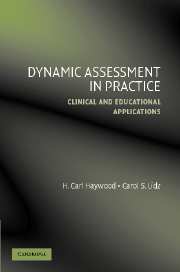Book contents
- Frontmatter
- Contents
- Preface
- Foreword, by Kenneth A. Dodge
- Foreword, by Thomas Oakland
- PART ONE THEORY AND PRINCIPLES
- 1 Dynamic Assessment: Introduction and Review
- 2 A Model of Mental Functioning
- 3 General Procedural Guidelines for Conducting an Assessment That Includes Dynamic Assessment
- PART TWO APPLICATIONS
- APPENDIX A TESTS REFERRED TO IN THE TEXT THAT DO NOT BELONG TO THE AUTHORS
- APPENDIX B SOURCES OF DYNAMIC ASSESSMENT MATERIALS
- References
- Author Index
- Subject Index
- Tests and Testing Materials Index
3 - General Procedural Guidelines for Conducting an Assessment That Includes Dynamic Assessment
Published online by Cambridge University Press: 04 December 2009
- Frontmatter
- Contents
- Preface
- Foreword, by Kenneth A. Dodge
- Foreword, by Thomas Oakland
- PART ONE THEORY AND PRINCIPLES
- 1 Dynamic Assessment: Introduction and Review
- 2 A Model of Mental Functioning
- 3 General Procedural Guidelines for Conducting an Assessment That Includes Dynamic Assessment
- PART TWO APPLICATIONS
- APPENDIX A TESTS REFERRED TO IN THE TEXT THAT DO NOT BELONG TO THE AUTHORS
- APPENDIX B SOURCES OF DYNAMIC ASSESSMENT MATERIALS
- References
- Author Index
- Subject Index
- Tests and Testing Materials Index
Summary
It is clear from observing how we proceed in our own assessments, as well as from the way we teach others to do assessments, that DA is not all we do, although it can be an important enterprise on its own. Any good assessment is designed to respond to referral questions, as well as to questions and issues that arise during the course of the assessment. We need a full and varied repertoire of procedures and approaches, and we need to be aware of the data available from each of these. We need to begin with establishing the individual's zone of actual development within any of the domains addressed by the assessment, only then moving on to developing zones of proximal development. These zones of proximal development do not need to be established for each and every functional area but are best reserved to target areas determined to be at risk for the specific individual. With this approach, incorporation of DA into the assessment need not add a tremendous amount of time to the process. Indeed, there are many times when only 20 to 30 minutes are needed.
Depending on the referral issues, it is also possible that many of the procedures that assessors automatically administer are not necessary, and the assessor can move fairly rapidly into exploration of the area of concern and spend more time with DA procedures without using unnecessary time on those that fail to provide relevant information.
- Type
- Chapter
- Information
- Dynamic Assessment in PracticeClinical and Educational Applications, pp. 35 - 46Publisher: Cambridge University PressPrint publication year: 2006



